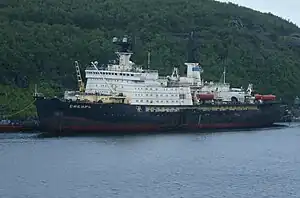 Sibir in 2012 | |
| History | |
|---|---|
| Name | Sibir (Сибирь) |
| Namesake | Russian for Siberia |
| Owner | Russian Federation |
| Operator | FSUE Atomflot |
| Port of registry |
|
| Builder | Baltic Shipyard |
| Yard number | 701 |
| Laid down | 26 June 1974 |
| Launched | 23 February 1976 |
| Commissioned | 28 December 1977 |
| Decommissioned | 1992 |
| In service | 1977–1992 |
| Identification |
|
| Status | Being demolished[1] |
| General characteristics [2] | |
| Class and type | Arktika-class icebreaker |
| Tonnage | |
| Displacement | 23,000 tons |
| Length | 148 m (486 ft) |
| Beam | 30 m (98 ft) |
| Draught | 11 m (36 ft) |
| Depth | 17.2 m (56 ft) |
| Installed power |
|
| Propulsion |
|
| Speed | 20.6 knots (38.2 km/h; 23.7 mph) (maximum) |
| Endurance | 7.5 months |
| Crew | 189 |
| Aircraft carried | 1 × Mi-2, Mi-8 or Ka-27 helicopter |
| Aviation facilities | Helipad and hangar for one helicopter |
Sibir (Russian: Сибирь; literally: Siberia), built in 1977, is a retired Russian nuclear-powered icebreaker of the Arktika class. She is the only icebreaker of her class that does not feature a red superstructure.
She was withdrawn from service in 1992 and was reported in 2012 as being moored at Murmansk awaiting scrapping.[4]
She has a gross tonnage of 20,655 and a dead weight of 4,096 tonnes.[3]
References
- ↑ "Reactors removed from «Sibir»". thebarentsobserver.com. Retrieved 24 July 2022.
- ↑ "Atomic Icebreakers Technical Data". rosatomflot.ru. Retrieved 9 October 2017.
- 1 2 3 "SIBIR". www.marinetraffic.com. Retrieved 24 April 2015.
- ↑ Pettersen, Trude (26 January 2012). "Russia scraps three nuclear icebreakers". Barents Observer. Retrieved 19 December 2013.
This article is issued from Wikipedia. The text is licensed under Creative Commons - Attribution - Sharealike. Additional terms may apply for the media files.